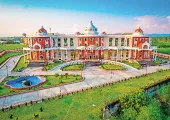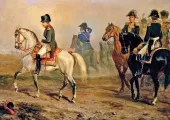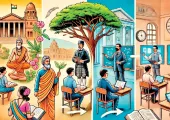Origin of Life (Part - 3)
Pre-Christian Tradition (Civilization) Systems (Part 1: From Sumer to the Indus Valley Civilization: 9-10)
On

Dr. Chandra Bahadur Thapa
Finance and Legal Consultant- Board of Education of India and Legal Consultant Patanjali Group
Chinese and Greek Civilisation (9) Chinese Civilisation
Soon after the founding of the People's Republic of China, 39 ethnic groups were recognised by the first national census in 1954. This increased to 54 in the second national census in 1964, with the Lhoba group added in 1965. The last change was the addition of the Jino people in 1979, bringing the number of recognised ethnic groups to the current 56. Chinese civilisation is one of the oldest civilisations in the world, which flourished in the valley of the Huangho and Yangtze rivers. It is one of the few civilisations that developed its own independent writing system in ancient times. Printing press, paper making, ammunition, playing cards, silkworm rearing, porcelain pottery, kite flying, writing time and compass are the gifts of this civilisation. Based on archaeological evidence, human settlement in China is about 22.5 lakh years old. The remains from Zhoukoudian Cave are 3 to 5.5 million years old and belong to Peking Man, a Homo erectus who used fire. Remains of modern humans in China have been found in the Liujiang region of Guangxi, including part of a skull that dates to 67,000 years ago. Although the dates of the Liujiang remains are controversial, a skeleton from Minatogawa, Okinawa, Japan dates to 18,250±650 to 16,600±300 years ago, meaning modern humans had arrived in China before that time. The first unified Chinese state was established by the Qin dynasty in 221 BC, when the court of the Chinese emperor was established and the Chinese language was forcibly standardized.
There is no concept of religion in Chinese
Historically, there has been no concept or overarching name for 'religion' in the Chinese language. In English, the terms 'popular religion' or 'folk religion' have long been used to describe local religious life. In Chinese academic literature and common usage, 'folk religion' (Chinese: 民間宗教; pinyin mínjiān zōngjiāo) refers to specific organized folk religious sects. Religion in China is diverse, and most Chinese people are either non-religious or practice a combination of Buddhism with a worldview collectively called Chinese folk religion. 'Chinese folk religion' is the ancient and indigenous or local religion of China. This religion involves the worship of nature, the universe, the planets, etc., as well as mountain gods, local village gods, ancestors, ghosts, and the ruling deity of the universe. This religion shows considerable influence of Indian philosophy Confucianism, Taoism and Buddhism.
From 220 BC to 206 AD, Han dynasty rulers extended the borders of their empire through military expeditions that extended into present-day Korea, Vietnam, Mongolia and Central Asia, and helped establish the Silk Road across Central Asia, leaving an indelible mark on Chinese culture. After the fall of the Han, China again descended into anarchy and another era of diversification began. Independent Chinese states established diplomatic relations with Japan during this period, bringing Chinese writing skills there. In 580 AD, China was once again unified under the rule of the Sui dynasty, which lasted until 614 AD, when the Sui dynasty collapsed after defeat in the Goguryeo-Sui Wars. Subsequent Tang and Song dynasties continued to unify Chinese culture and technology reached their peak. Song dynasty world was the first government in history to issue paper currency and the first Chinese civil system to establish a standing navy. China's population doubled in the 10th and 11th centuries, due mainly to the spread of rice cultivation to central and southern China and the production of abundant food. The Northern Song dynasty alone had 100 million people living within its borders. The Song dynasty was China's cultural heyday, when art, literature, and social life flourished. From the 7th to the 12th centuries, China became the most cultured country in the world. In 1271, the Mongol chieftain Kublai Khan founded the Yuan dynasty, which overthrew the Song dynasty by 1279. At the same time, the famous European traveller and trader Marcopolo reached China from Venice with his father and uncle and worked in the court of Kublai Khan, the details of which he described in his diary and made public on his return, as a result of which the attention of Western countries turned towards China and many travellers from Italian cities also came to China in connection with their travel to the Near East. Apart from this, Roman Catholics also tried to establish relations with China. A farmer chased away the Mongols in 1368 and established the Ming dynasty which lasted till 1664. The Qing dynasty established by the Manchus ruled China till 1911, which was the last dynasty of China. Many trade difficulties arose due to the inconveniences of transportation while travelling from Western countries to China. All the traders of Europe and Asia used to first cross the Red Sea with their trading ships and then after circumnavigating Egypt, they used to come and land in the Mediterranean Sea. There was another route for trade as well. They used to start their trade journey from the Gulf of Iran. Departing from the Gulf of Iran in connection with the journey, visiting countries like Basra, Baghdad, Mecca etc. they reached Asia Minor, where they had to waste a lot of time and the traders had economic relations with certain countries it could not be sustained, that is why these days the eastern countries Western countries could not establish relations with Pakistan. Not only this, later in the second half of the fifteenth century, their surviving merchants roads were also blocked. 1453 AD. in Muhammad II of the Turkish race captured Constantinople and their trade routes the Mongol ruler Yuan was still alive till then some contact between foreigners and China was definitely maintained but as soon as it died, it seemed like that now their mutual relations will end. But the Ming emperors revived this relation and turned towards the western countries. With the passage of time, the traders of western countries could not forget the economic prosperity of eastern countries (especially China). Marcopolo's diary became a source of inspiration for them. As a result, between the end of the fifteenth century and the beginning of the sixteenth century, the travel of these travellers started again and their travel also started expanding. At this time, the Spanish, Dutch and Russian races helped in furthering the relations towards the eastern and northern regions of Asia. Getting inspiration from Spain and Portugal, a traveller named Columbus along with his fellow travellers reached Portuguese Macau (China) in 1511 AD and started living permanently in Macau. The Chinese considered these Portuguese as uncivilized and troublesome. At this time the British also came to China. When the rule of the Ming dynasty was ending and the rule of the Manchu emperor was about to begin, the British of Britain arrived in China. Later, he became the most influential person in China and got the credit for opening the doors of China for trade with Western countries.
Reach of Western countries to Eastern countries
The first race that arrived in East Asia during the reign of the Ming dynasty was the Portuguese. In 1498, Vasco da Gama set foot on Indian soil while travelling along the African coast. The Portuguese traveller Vasco da Gama benefitted from this journey as people from the western countries, mainly the Portuguese, came to know the route to reach the eastern countries. Therefore, their migration and expansion started in other countries as well. They reached China at the beginning of the 16th century when they captured Malacca. They reached China in 1514. As soon as they reached China, they got involved in business activities. The traders here started buying luxury items from China and started selling them in the western countries where there was a demand for cosmetics. By now, many western races had arrived in China. The Portuguese had arrived in 1516, the Spanish had arrived in 1575; The Dutch arrived in 1604 AD and the English came in 1637 AD. But till this time the Americans and Russians had not been able to come. They also arrived in China during the Ching rule.
The Portuguese could not please the Chinese with their behavior. Their behavior and habits were not good. It was not only the Portuguese who were bad, other races also had similar habits. When the Spaniards came to America, then they reached there, the lives of the indigenous peoples also became very difficult because of them. Despite the opposition of the Spaniards, they did not leave America and settled there by building colonies. As soon as they settled there, they started interfering in the religion, culture, lifestyle etc. of the American people. Not only this, along with the construction of colonies, they gradually turned towards building colonies. In this series, the Spaniards also reached China. After the Portuguese, the Spanish came to China. The Chinese were already familiar with the kind of activities this race had done in America. Therefore, as soon as this race arrived on Chinese soil with the seeds of building colonies, the Chinese started opposing them. The Ming government also started a strong movement against this race. This was the reason that the Spaniards could not succeed in China like in America. They could neither establish their existence in China nor could they build the desired colonies. Trade relations were also established with the Portuguese. This relationship could not be established with them. Still the Spanish were adamant. Just as they had started living forcefully in America, they tried to live in China in the same way. A group of them stayed in China's famous port Canton and tried to establish trade relations with China. Finally, in the latter half of the eighteenth century (1557 AD) they got success in their work and started living in Macau by building their colony there.
At the same time, many religious missionaries from the West also came to China. These missionaries started preaching religion in China. Initially, the behavior of these missionaries was good, but later the people of China became aware of their selfish policies. At the same time, the British and the Dutch also arrived in China. But here it should be remembered that during the rule of the Ming Dynasty, China established two types of relations with the Western countries - one was trade relations and the other was religious relations. The Western countries used to trade the southern lands with Macau and Canton. The Western traders brought many grain-related plants and tobacco from their countries to China. These people propagated tobacco a lot. Due to them, most of the people of China started consuming tobacco. Similarly, their religious relations with China were also established. Missionaries from Western countries used to preach religion in the inner areas of China. After the rule of the Mongols, the Christians in China started coming to an end and their influence started decreasing. But during the Ming Dynasty, the Christian population in China started declining the last years of the rule, Roman Catholics revived these Christians and their missionaries. At the same time, people from many religious sects like Franciscan, Augustinian, Jesuit, Dominican etc. reached China from Britain, France etc. In the early years of the sixteenth century, the dominance of the Jesuit sect started getting established in China. The popular propagator of this sect was Francis Xavier who tirelessly tried to make this sect popular in South and East Asia. This preacher also propagated this sect in China. In fact, it was only because of Xavier that this sect could come alive in China. Xavier had not yet achieved complete success in his work when he passed away in 1556 AD. After his death, Mathar Ricci took the responsibility of his work on his shoulders. Ricci was a resident of Italy. He put in all his efforts to increase the popularity of the Jesuit sect. Ricci had a multifaceted talent. He was a great scholar of astrology and mathematics. Historians estimate that at present there was no scholar of astrology and mathematics in China who could match Ricci. Due to his talent, he also studied Chinese literature. This Chinese literature was a completely new subject for Ricci, yet due to his perseverance and talent he gained a lot of respect among Chinese litterateurs. Apart from studying his own religion, he also studied Confucianism and Christianity in great depth and tried to keep the similarities and differences of both the religions as a scholar. He made his residence in the capital of China, Beijing. At the same time, Spaniards also came to China from Philippines.
In 1644, the rule of Ming dynasty ended. In the north, conquerors called Manchus defeated Ming. Manchus were residents of Manchuria. In the latter half of the sixteenth century and the early years of the seventeenth century, they made themselves powerful and snatched Mukden from Ming, which was also their capital. They also made Mukden their capital. The Mongols living in China also willingly or unwillingly accepted the rule of Manchus. Manchus tried to extend their state boundary to the southern wall of China. At the same time, when a feeling of discontent against Ming arose in China, the Manchus took advantage of the opportunity and took control of Peking and from then on they started ruling China. Kangsi (1661-1728 AD) and Chin Lung (1736-1796 AD) were the most glorious kings of this dynasty. Manchus ruled China for a long time.
To Continue....
Tags: Origin of life
लेखक
Related Posts
Latest News
01 Dec 2024 18:59:48
योग प्रज्ञा योग - योग जीवन का प्रयोजन, उपयोगिता, उपलब्धि, साधन-साधना-साध्य, सिद्धान्त, कत्र्तव्य, मंतव्य, गंतव्य, लक्ष्य, संकल्प, सिद्धि, कर्म धर्म,...








.jpg)




